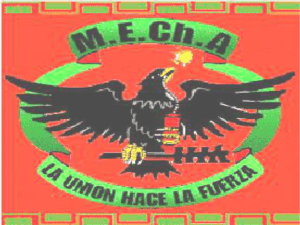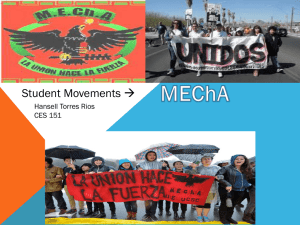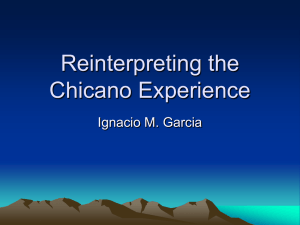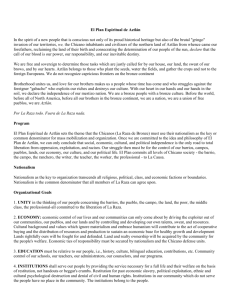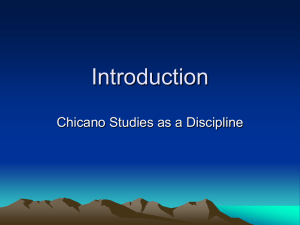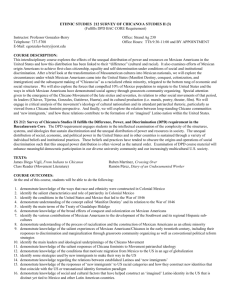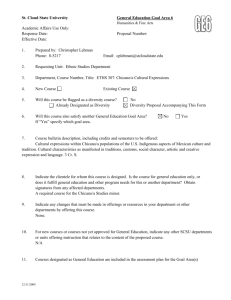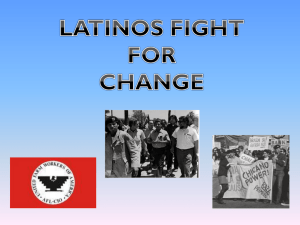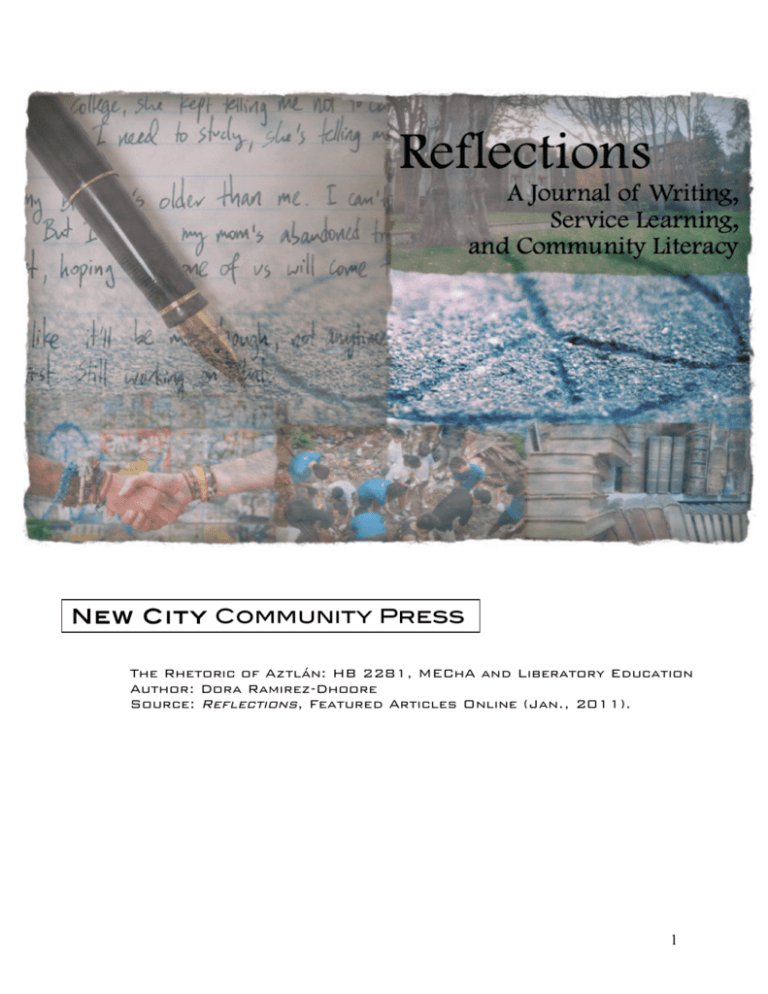
New C ity Community Press
The Rhetoric of Aztlán: HB 2281, MEChA and Liberatory Education
Author: Dora Ramirez-Dhoore
Source: Reflections, Featured Articles Online (Jan., 2011).
1
The Rhetoric of Aztlán: HB 2281, MEChA and Liberatory Education
In the spirit of a new people that is conscious not only of its proud historical heritage but
also of the brutal "gringo" invasion of our territories, we, the Chicano inhabitants and
civilizers of the northern land of Aztlán from whence came our forefathers, reclaiming the
land of their birth and consecrating the determination of our people of the sun, declare that the
call of our blood is our power, our responsibility, and our inevitable destiny.
We are free and sovereign to determine those tasks which are justly called for by our
house, our land, the sweat of our brows, and by our hearts. Aztlán belongs to those who plant
the seeds, water the fields, and gather the crops and not to the foreign Europeans. We do not
recognize capricious frontiers on the bronze continent.
Brotherhood unites us, and love for our brothers makes us a people whose time has come
and who struggles against the foreigner "gabacho" who exploits our riches and destroys our
culture. With our heart in our hands and our hands in the soil, we declare the independence of
our mestizo nation. We are a bronze people with a bronze culture. Before the world, before all
of North America, before all our brothers in the bronze continent, we are a nation, we are a
union of free pueblos, we are Aztlán.
–Alurista, “El Plan Espiritual de Aztlán”
THE LEGISLATURE FINDS AND DECLARES THAT PUBLIC SCHOOL
PUPILS SHOULD BE TAUGHT TO TREAT AND VALUE EACH OTHER
AS INDIVIDUALS AND NOT BASED ON ETHNIC BACKGROUND.
–Arizona House Bill 2281
It is only when the oppressed find the oppressor out and become involved in the
organized struggle for their liberation that they begin to believe in themselves.
--Paulo Freire, Pedagogy of the Oppressed, 47
In March 1969 at the first national Chicano Liberation Youth Conference hosted by the
Crusade for Justice in Denver, Colorado, a young poet named Alurista read “El Plan Espiritual
de Aztlán” which forged the ideas of “the bronze continent” and “Aztlán” (Anaya and Lomeli 1).
This historical document, often deemed a manifesto of Chicanismo, or a militant ethosi,
advocated Chicano nationalism and self-determination for Mexican Americans. Today, it
continues to be one of the founding plans of the student organization, Movimiento Estudiantil
Chicano de Aztlán, or MEChA. MEChA, which “has been one of the more important student
organizations to address the issue of education” (Vargas 378), focuses on the organizational
goals laid out in the plan, including: Unity, Economy, Education, Institutions, Self Defense, and
Cultural and Political Liberation. Included in this plan is the idea of “reclaiming the land of their
birth,” or the land annexed to the United States in the 1848 Treaty of Guadalupe Hidalgo.
2
In recent years, the idea of Aztlán has literally been defined as land reclamation by many
Chicana/os, but as “homeland invasion” by conservative individuals, and has triggered much of
the protest against MEChA and programs that frame community pride (brown or Chicana/o) and
self-affirmation as an element of their educational goals. This is especially poignant, as the
growing Latino population has become a reality, leading to the increase of Euroamerican antiimmigration rhetoric and the externalized and internalized colonialism many Chicana/o students
face while in the American education system. Accordingly, this essay draws on the educational
and political history of the Chicana/o student in the academy by focusing on MEChA as a
student organization that has historically relied on the rhetoric of Aztlán as a tool for liberatory
education.
The connection of Mexican Americans to land has been portrayed in literature by the use
of territory as a central character in Chicano political movements, often referencing 1848 as a
historical crux. Rafael Pérez-Torres references Aztlán as a place, not of reclamation, but of selfaffirmation,2 while Luis Leal describes Aztlán as a myth which, “symbolized the existence of a
paradisiacal region where injustice, evil, sickness, old age, poverty, and misery do not exist” (8).
Leal also recognizes that “Aztlán symbolize[s] the spiritual union of the Chicanos, something
that is carried within the heart, no matter where they may live or where they may find
themselves” (8). In the face of anti-Mexican sentiments in a globalized world, both Alurista and
Leal reference the heart in the hand and the hand in the soil of where one lives. Aztlán, as an
utopian idea of the mythical homeland, has empowered many student voices and student groups,
and is used as a rhetorical technique to protect Chicano culture. As Pérez-Torres explicates,
“Consequently, the transformation of the pre-Cortesian into fetish reinforces a type of cultural
erasure at the same time that it seeks to articulate a vision of self-identity liberated from the
models of Euroamerican dominance” (48). Despite this paradox, the idea that the rhetoric of
3
Aztlán can be used as a tool or mechanism for student empowerment as well as a way that
confounds Euroamerican dominance is important to this argument.
With the intention of exploring indigenous histories threatened by state legislation and
individual political agendas, I find it worthy to examine the ramifications of the political idea(l)s
that are modeled in Arizona’s House of Representatives Bill 2281 (HB 2281),ii a bill which
clearly illustrates an inability to listen to the voice of the minor-ity.iii I use Trinh T. Min-ha’s
articulation of “minority” to clarify my stance that the term represents the political voice of the
Mexican American population in the political system. I am not referring to a population count in
any specific state. Throughout this discussion, I analyze the way conservative rhetoric has used
the concept of Aztlán as a geographical space to silence Chicana/o voices and have defined it in
direct opposition to an American value system in education that Sandy Grande explicates in Red
Pedagogy: Native American Social and Political Thought:
By the 1950s, liberal educators were championing the notion of cultural pluralism
as the pathway to democracy, imbricating the constructs of national unity,
multicultural harmony, and inclusion as the guiding principles of American
education. Within this rhetoric, schools were to become an extension of the public
sphere, a place where citizens could participate in the democratic project by
coming together and transcending their racial, class, and gender differences to
engage in “rational discourse.” (33)
As a result, MEChA and Ethnic Studies programs that teach the history of Aztlán and resist
blanket assimilation are often juxtaposed against “rational discourse.” This neutral and rational
discourse is purported to be found in the textbooks schools adopt for an American/U.S. education
curriculum, thus I will explore aspects of those texts monitored by school boards because of such
bills as HB 2281. Those texts held suspect by the authors of this bill are Paulo Freire's Pedagogy
4
of the Oppressed and Rodolfo Acuña's Occupied America; both incorporate aspects of liberatory
education for Chicana/o students. Concurrently, because HB 2281 directly references Mexican
and Chicano students, I examine these legislative and curricular actions, action that has
historically restricted students of color from gaining social capital. I conclude with a call for a
new orientation among those who study and teach students of color. It is also a call for educators
to examine the systems students must negotiate in order to achieve an outlook that can further
their education.
The Minor-ity Perspective
The rhetoric found in HB 2281 is consistent with the persistent propensity by state
government to further devalue the minor-ity’s voice in the classroom and the academy. The bill
also reflects how the rhetoric of Aztlán is listened to and interpreted by the general public, who is
unaware of the history behind this concept. Trinh T. Minh-ha defines the social constructs
influencing the way we approach the language of the “minor-ity” through a Euroamerican
dominant lens when she states, “Remember, the minor-ity’s voice is always personal; that of the
major-ity, always impersonal. Logic dictates […o]ld stereotypes deriving from well-defined
differences (the apartheid type of difference) govern our thought” (28). White privilege scholar
Tim Wise adds to this conversation when he discusses this phenomenon: “I think many folks of
color are understandably upset to a degree by the fact that a white man can say things they've
been saying for years and be taken more seriously in the process” (Hines). Here he points to the
existence of the social inability to listen to the voices of people of color in the academy.
Constricted by procedure and legislation, it is even more difficult to build the bridges that many
scholars have called on education to build because along with a variety of other restrictions,
exclusions and legal inclusions, the House bill targets “pupils of a particular ethnic group,”
5
specifically Chicano/a students. The rhetoric which focuses on only the negative attributes of the
Ethnic Studies programs being targeted in this bill (specifically the Mexican American Studies
Department in the Tucson Unified School District or MASD), reflects the major-ity perspective
of the minor-ity’s voice and viewpoint. As a consequence, this major-ity perspective does not
take into account the body of knowledge Chicana/o Studies has developed, often leaving it out of
a school’s curriculum.
Political Idea(l)s in History and Texts
Paying attention to the textbooks that are used in the classroom is a way to revisit how
history shapes our understanding of social meaning and power structures—creating an avenue
for allowing the minor-ity voice into textbooks and the classroom. Negationism draws on the
apprehension the American public has about revisiting the annals of people of color in the United
States. Slavery and internment camps hold rhetorical power and are well known, but other lessknown histories are not considered possible because they are framed within a different
perspective, whether through another language, historical memory, or because the oppressed
group is still under current rule. In Richard Delgado’s essay, “The Law of the Noose: A History
of Latino Lynching,” he discusses the large numbers of Latinos (about 597 or more) that were
lynched during “the same period when black lynching ran rampant” (299). Delgado uses the
rhetorical power of the lynching of Blacks in his argument because he concedes that the
dominant group understands this historical moment as possible. He continues, “Latinos and the
Law, after reviewing the evidence, concludes that Latino lynchings are a relatively unknown
chapter in United States history and part of a worldwide pattern of shaping discourse so as to
avoid embarrassment of the dominant group” (303). This is a rhetorical move on Delgado’s part
in order to align history with a past that is already understood and perceived as correct by the
6
dominant group in the United States, giving symbols, such as the noose, which represents racism
through a segregationist and violent lens, a stronghold on the social imagination.
The rhetoric used in HB 2281 is an artifact of the public’s ignorance of the history of
Mexican Americans in the United States. The bill targets members of the Latino population, and
in particular, students. This bill makes it evident that the authorship of a text and the ethnicity of
the author can be questioned in the educational system. Minh-ha and Wise’s premise that the
minor-ity’s voice is not given precedence or even a small advantage over the oppressor’s voice is
very apparent in the negative attention being paid to Freire’s and Acuña’s texts. Acuña’s
Occupied America is particularly interesting because it incorporates the obscured history of
Mexican Americans in the United States—and it is this history that is being targeted. In an article
in the LA Times, superintendent Horne is described as having
[…] been trying to end the program for years, saying it divides students by race
and promotes resentment. He singled out one history book used in some classes,
“Occupied America: A History of Chicanos,” by Rodolfo Acuña, a professor and
founder of the Chicano studies program at Cal State Northridge. “To begin with,
the title of the book implies to the kids that they live in occupied America, or
occupied Mexico,” Horne said last week in a telephone interview. (Cruz)
According to Horne, his focus on Freire and Acuña’s texts stem from his wish for students to
value individualism, which promotes an understanding of global events from an individualized
locus. Unfortunately, thinking locally allows for the individual to maintain a “symbolic cultural
activism” and to feel self-contained (safe). Through individualism, the oppressor is able to
maintain the status quo by segregating students from developing a community, from
understanding history from a perspective that is culturally significant to them, and from
experiencing education from a perspective that is usually unavailable to a Chicano/a student.
7
Delgado gives insight into the importance of voice, narrative and storytelling told from a
distinctive cultural group (Black and Latino). He equates English-Only orthodoxy to that of
lynching when he writes:
We should emphatically reject any such laws and practices. Moreover, scholars
should unearth other laws and customs that operate on distinct minorities the way
language regulation operates on Latinos. Otherwise, marginalized groups will find
themselves in a condition similar to that which the postcolonial scholars
describe—alienated from themselves, co-opted, and unable to mount serious,
concerted resistance to illegitimate authority if not dead. (312)
Thus, by reading Acuña’s text, Freire’s text, and the Plan of Aztlán as historical documents,
MEChA members and students are pushed to connect the present with memory—to understand
the paradoxes of present culture.
In contrast, Diana Hull, a former conservative member of the Sierra Club's Population
Committee and the Southern California Demographic Forum, explains what she considers the
role of Acuña’s text to be in her essay, “Rodolfo Acuña: A Chicano Warhorse Goes to Court”:
Inventing a new ethnic brotherhood called Chicanos was no more brazen than
inventing a new religion in the manner of Joseph Smith. Raza leaders were
classical mythmakers with self-righteous energy and contagious ideas. The goal
of Chicano Studies was to maintain identity, language and culture in the
interregnum, while Chicanos grew their numbers and trained to retake Professor
Acuña's “occupied America.” (204)
This perspective has carried into the national debate regarding the use of this text in the MASD
curriculum. Hull condemns the use of this text by her use of the slogan, “retake […] America” as
her method of argument. In Freire’s text, he addresses this use of slogans when he differentiates
8
the distinction between dialogue and monologue. He writes, “But to substitute monologue,
slogans, and communiqués for dialogue is to attempt to liberate the oppressed with instruments
of domestication […] to treat them as objects which must be saved” (47). Because of the way
cultural myths work, Hull is able to equate Raza leaders with Mormons—a group whose history
has been defined as anti-American and anti-democratic by both conservative and liberal media
standards. Then she quickly categorizes Mexican American students as blank slates needing to
be saved and taught values consistent with the status quo. Consequently, Hull’s (and Horne’s)
critiques fail to reflect on the disconnection between a historical consciousness from a minor-ity
perspective and that of the status quo, major-ity or mainstream population.
The Rhetoric of Aztlán
In Chicanismo: Forging a Militant Ethos among Mexican Americans, Ignacio M. Garcia
understands this disconnection as untranslatable because terms like self-affirmation, liberation,
Brown Power, and Aztlán are “foreign terms and [have] no translatable application to the
American political system” (141). Consequently, it becomes easy to dismiss education programs
that focus on ethnicity and liberation politics because the commonplace rhetoric encourages
attitudes that segregate according to nationalistic slogans and manipulation.iv The terms that are
used, such as “liberal,” “communist” and “victimhood,” become myths that are difficult to
unravel. Because of such media/social myths, Hull’s commentary—on Acuña’s text and the
students who read it—is able to gain momentum, even among conservative Mexican Americans.
She expounds: “MEChA members hawk the message of victimhood and seed the movement by
recruiting for Chicano Studies classes. They do most of the protesting, the marching, the fasting
and the taking over of university buildings. There are MEChA chapters in 90 percent of
California high schools and in colleges and universities all over the nation” (203). This statement
9
defines MEChA members as predatory “hawk(s)” that “take over” and prey on young students to
recruit other students into “victimhood.” This rhetoric, which incorporates Aztlán as the reason
for a “homeland invasion,” is used to target MEChA, and to solidify the shift toward apathy in
student perceptions and attitudes as a whole, promoting the internalization of racism.
Consequently, there is a need to examine the way students within MEChA and those
outside of this group respond to anti-immigration and anti-Mexican sentiments that are found on
school campuses. Rhetoric affects how individuals think critically about local and global issues,
with one end result being how internal and external colonialism affects student group
interactions on campus. One of the sub-questions needing examination in this process is why
some students feel compelled to identify with a political group, such as MEChA, and why other
students find that identification difficult to accept for themselves, and consequently for others as
well. This moment of self-affirmation is vital in understanding why some students are timid
when expressing their personal political views, while others feel empowered to share their
histories. This lack of self-affirmation for Chicano/a students is what Acuña understands as the
“deconstruction of the Chicano identity” (Occupied America 272). In Occupied America, Acuña
gives the act of redefining terms a great sense of power. He writes, “In order to change the
common sense of the American public, words such as racism and victim were redefined” (272).
As Acuña outlines how this redefinition occurs, he focuses on how the government legitimizes
racism by concerning itself with the poverty, education and migration patterns of Mexican
Americans through the act of lawmaking. He also notes the sparse numbers of Latinos in
government positions throughout his text. As noted in the history Acuña provides in his text,
Mexican Americans specifically have been a target of legislative oppression at the state and
national level for many decades, and this history has affected students and student groups in the
U.S. education system.
10
Living in the Duality of Legislative Oppression
To further understand the idea of self-affirmation for Chicano/a students, I return to a
historical perspective of Chicanismo, defined as a militant ethos within MEChA and its tie to
identity formation for students. Since the mid 1970s, there has been a downward shift in the
political consciousness of student groups, especially with the loss of the Black Power Movement
and other political student groups on campuses across the nation. In “Epoch of the Viva Yo
Hispanic Generation (1975-1999),” Edward Navarro describes the events that led to the demise
of the Chicano movement in general. He describes the factors that “contributed significantly to
the demise of [Chicano] movements [as] law enforcement’s use of espionage, infiltration,
subversion, and judicial litigation against its organizations and leaders. From the police to the
FBI’s COINTELPRO, law enforcement agencies sought and in most cases succeeded in
destabilizing and neutralizing their effectiveness” (402). Movements that were targeted by our
government’s gate keeping practices were the Raza Unida Party (Jose Angél Gutierrez), the
Crusade for Justice (Corky Gonzalez), and the Brown Berets (Carlos Montes and David
Sánchez) (Navarro 402). A culture of fear came to influence how political organizations were
perceived, and this in turn led to a movement away from joining “militant” or “radical” political
groups, especially in the 1980s and 1990s. On many campuses, MEChA found itself competing
for members with groups like MASA, OELA, AMAS, and other groups that focused on
promoting cultural awareness, while strategically avoiding (though not entirely) political and
controversial issues.
In addition to the societal debates MEChA members were having with other Mexican
American student groups, in “The Chicano Experience in Contemporary America,” Zaragosa
Vargas reminds us of the backlash against difference in the 1980s: “Reaganism exacerbated
11
racial hostilities, which further eroded the gains made by minorities. The so-called white
backlash and the rightward turn in national politics led to the suspensions of affirmative action
efforts” (440). The 1980s and 1990s retrenched to abolishing bilingual education and creating an
environment that persuaded adults and children into believing that class was the only basis of
their oppression. Such conservative political rhetoric encouraged them to believe that their race
could be ignored if they believed in Reaganism. Such politics erased the history of their Mexican
ancestors, promoted assimilation, and blurred cultural, political and personal identity to the point
of erasure in order to achieve individualism. This rhetoric gained fuel as “Racial minorities and
women earned the attention and disfavor of the New Right spokespersons whose charge of
‘reverse discrimination’ became their main ideological weapon” (Vargas 440). Many gains were
lost and government programs such as Affirmative Action were attacked.
In recent decades, Mexican American students have been affected by a variety of
legislation, including the 1986 Immigration Reform and Control Act which punished the worker
and not the employer who continued to hire undocumented workers, the North American Free
Trade Agreement of 1993 whose affects are deeper than this essay can cover, Proposition 187 in
1994 which denied undocumented workers from using social services, Proposition 209 in 1996
which amended the state constitution to prohibit public institutions from considering race, sex, or
ethnicity (Vargas 440), the Civil Rights Initiatives in California and Michigan, the various bills
to adopt English-Only laws, and those bills meant to abolish bilingual education in states across
the nation (Colorado, Prop227-CA, Prop 203-AZ). This legislation affects individuals directly
and socially by sending a message of blame to the Mexican and Mexican American population—
students included. Added to this list are AZ SB 1070, which requires immigrants to carry proof
of citizenship, and AZ HB 2281 (2009-present) which is treated in this essay and is central to
education.
12
Together, this legislation and the history it supposes push students to “live in the duality
in which to be is to be like, and to be like is to be like the oppressor” (Freire 30). This in turn
leads to “symbolic cultural activism” (Navarro 498) for students who are (to use a well known
slogan or cliché) “afraid to rock the boat.” The boat is an internalization of these issues and a
move away from true political or social activism. This choice could be due to a variety of factors,
including the need to feel safe on campus, feel included in classroom conversations and
“communities,” and above all, make sense of the internalization of years of oppression. It is not
difficult to see why Freire’s text, which advocates oppressed beings participating “in developing
the pedagogy of their liberation” (30), is a target of the oppressor (HB 2281 proponents), because
“It is only when the oppressed find the oppressor out and become involved in the organized
struggle for their liberation that they begin to believe in themselves” (Freire 47).
In order to continue the language of the oppressor, there are cultural myths at work in HB
2281. There is an image of what the oppressor looks like and what the oppressed look like. The
question of who is a proponent of this bill and who is against this bill delimits those categories;
often, “White Arizonians” agree with the bill while “Mexicans” do not. This sets up false
borders—by nationality and consequently race. In addition, living through the duality of
legislative oppression causes ethnic self-identifications to shift as assimilation occurs. It is this
duality that targets students—and it is this duality that Ethnic Studies programs attempt to
deconstruct. These laws caricaturize the Mexican as criminal and uneducated, and vilify those
that are phenotypically dark-skinned, while socially forcing an individual to make a choice for
themselves between assimilation or keeping their caricaturized culture. This advances the
concept of “individualism” as a mode of American “success” for students.
MEChA and the Aftermath of History
13
In 1969, the members of the Chicano Coordinating Council on Higher Education focused
on the connections MEChA could make between the community and higher education—the
campus and the barrio. In this document, they remind students that “MEChA must bring to mind
of every young Chicano that the liberation of his people from prejudice and oppression is in his
hands and that this responsibility is greater than personal achievement and more meaningful than
degrees, especially if they are earned at the expense of his identity and cultural integrity” (384).
Within this discussion, they also focus on the ideas of supportive groups, sympathetic
administrators and community. They end their written statement with the idea “Of the
community, for the community. The spirit speaks for the Race” (Vargas 386).
It is apparent that student voices tied with community voices are a strong mouthpiece for
the Mexican community. In 1967, Los Cinco was formed. Within this group were five Chicano
activists who began the Mexican American Youth Organization (MAYO): Jose Angel Gutierrez,
Juan Patlan, Willie Velasquez, Ignacio Perez, and Mario Compean (Navarro The Mexican
American Youth Organization 393). These young men “were cognizant of the contributions
made by Chicano organizations such as the League of United Latin American Citizens
(LULAC), the GI Forum, and the Political Association of Spanish-speaking Organizations
(PASO), [but] they were [also] critical of their conservatism and saw them as not doing enough
for Chicanos […] They felt that these organizations were neither committed to nor capable of
providing advocacy for the Chicanos in the barrios” (Vargas 392). It is this connection to the
community, while maintaining a Chicanismo element, that MAYO has had and which helped it
gain momentum through Aztlán. MEChA members remember this political activism and
understand Chicanismo as being that of reclaiming the homeland of Aztlán—of “consecrating
the determination of our people of the sun,” and of declaring “that the call of our blood is our
14
power, our responsibility, and our inevitable destiny.” Aztlán is about working with the
community, for the community, and not just the individual.
In LULAC: Mexican Americans and National Policy, Craig Kaplowitz writes, “Chicanos
derided LULAC leaders as ‘Tio Tacos’ who rejected their cultural and racial heritage.
Chicanismo celebrated a culture and racial status different from Anglos, and for them la raza was
utterly distinct from whites” (130). What is interesting is that Chicanos and LULAC, much like
MEChA and other Mexican American Student Groups, do make “similar demands on civic
culture” (Kaplowitz 130). Therefore, how do students perceive MEChA and its membership? For
some students, the choice is an either/or relationship—be a Tio Taco or a Reies Tijerina, who in
1966 was arrested for occupying the San Joaquín del Río de Chama, a land-grant park in New
Mexico. Because students think they must choose either assimilation or Chicano/a activism,
there has been a move away from confrontational student politics towards an individual study of
issues, sometimes considered apathy. I use the term individual, rather than independent, because
many of the arguments rallied against the Mexican American Studies Department in the Tucson
Unified School District push for individualism and not community centered politics (hence the
redefinition of “community organizer” by the conservative media). In many ways, individualism
maintains segregation and allows for what Freire describes as “Divide and Rule” (122).
Assimilation through nationalism married with patriotism is utilized as a way that “deMexicanize(s) them but fail(s) to Americanize them as a group, allowing them into the
mainstream as individuals, not as a community” (Garcia 10). MEChA, which focuses on
community politics, opposes this plan to divide and assimilate. Even so, there are individuals that
move away from community-centered politics, leaving a fissure in a dialogue that could move
toward a more inclusive idea of community in America.
15
But current Euroamerican rhetoric continues to separate. The idea that “being political” is
“militant” or “confrontational” stems from some of the history I have outlined and the
internalizing of governmental and media influences. This rhetoric is widespread in popular
media channels. Terms such as “socialist,” “community organizer” and “liberal” are often
associated with organizations that are based in a historical and political consciousness. Certain
images in the media represent biased politics and MEChA is often targeted as being a militant
voice on campus, with photos of Brown Berets or stereotypical representations of undocumented
workers as poster children. Flyers, advertisements and editorials in newspapers mirror the
national rhetoric heralded against Chicano/a student groups and the larger Latino population—
specifically undocumented workers, unethically noted as “illegal aliens” and/or “invaders” in the
media and used as a method of dehumanization. One example of this sort of advertisement came
in the form of a flyer distributed by the College Republicans on the campus of Boise State
University. It stated: “Win a Dinner for two at Chapala’s Mexican Restaurant! Climb through
the hole in the fence and enter your false ID documents in the food stamp drawing.”v In an
Associated Press release, Ed Keener, the board chairman of the Interfaith Alliance of Idaho,
described the effects of this unwarranted rhetoric and stated, “It certainly singles out a particular
segment of students at the college and I’m pretty sure if you ask Hispanic students, this is beyond
the realm of humor […] It’s trying to hurt somebody” (Forester). These flyers prompted MEChA
students and other student groups to protest the particular event, but once the event was over, the
students’ activism dissolved. Armando Navarro defines this transient activism as “symbolic
cultural activism” (Navarro 498), which generally ties into the “ethos of their parents,” what he
terms the “Hispanic Generation” (498). I see it as much deeper than a generational issue and
want to draw attention to the educational system that legislates acceptance of the status quo—the
oppressor’s version of history.
16
Freire’s and Acuña’s texts are used in the classroom because they work well to unravel
the racial and economic attitudes found in state legislation and in such a flyer, many examples of
which can be found on campuses across the nation. Freire writes, “Conditioned by the experience
of oppressing others, any situation other than their former seems to them like oppression” (39).
In other words, because of global influences, immigration is perceived by the oppressor as the
“taking of American jobs and freedoms.” There is a two-fold approach to understanding this
widely used phrase. Acuña’s text lays out the history of the Bracero program and other worker
programs created by the government to bring workers to the United States, and Freire’s writings
help to theorize this phrase by pointing out its use of blatant stereotyping and misleading as
manipulation, where “the dominant elites try to conform the masses to their objectives. And the
greater the political immaturity of these people (rural or urban) the more easily the latter can be
manipulated by those who do not wish to lose their power” (128). This flyer and other artifacts
similar to it illustrate the manner in which the oppressor and the oppressed are simultaneously
dehumanized by this system of thought. Liberatory education attempts to move both groups
outside of this system and to inspire “true reflection,” which “leads to action” (Freire 48).
Negotiating the dialogue
Freire asserts that “to achieve praxis […] it is necessary to trust in the oppressed and in
their ability to reason” (48). Achieving this trust is where his text and Acuña’s text could help
lead people to praxis, where reflection leads to action. Minh-ha and Wise both acknowledge the
mistrust of the minor-ity’s voice and ability to reason and Attorney General Eric Holder
perceives this lack of trust as an issue related to our inability in being able to talk about race
across the color line. In his February 18, 2009 lecture at the Department of Justice regarding the
African American History Month Program, he stated:
17
Simply put, to get to the heart of this country one must examine its racial soul.
Though this nation has proudly thought of itself as an ethnic melting pot, in things
racial we have always been and continue to be, in too many ways, essentially a
nation of cowards. Though race related issues continue to occupy a significant
portion of our political discussion, and though there remain many unresolved
racial issues in this nation, we, average Americans, simply do not talk enough
with each other about race. (Justice News, itals mine)
Dialogue about race often begins with a cowardly statement filled with stereotypes,
inconsistencies, and negative overtones that are uninformed politically and economically but are
almost always subliminally influenced by the history of the colonized that is not taught in our
education system. This is the case with Arizona’s House Bill 2281.
Subsequently, the next step is to have a dialogue about the issues found in this bill, but as
long as political power is used to oppress another group, the conversation is merely a
monologue. Thus, whose responsibility is it to begin a dialogue about race and racism in
education? Proponents of HB 2281 have stated that Jan Brewer’s signature on the bill began this
dialogue while simultaneously making the argument that the left has ulterior motives in
maintaining Ethnic Studies programs in order to perpetuate the Democratic party’s base. Such
comments negate the power structures at work in the entire political system and fail to reveal
how the MASD student voices are silenced.vi Thus, a first step would be in listening to the voices
of the students and teachers that participate in the MASD program and other Ethnic Studies
programs across the nation.
Unfortunately, in attempting to achieve a dialogue, Freire would concede that “It would
be a contradiction in terms if the oppressors not only defended but actually implemented a
liberating education” (36). To realize the possibility of the oppressors actually implementing a
18
liberating education will be a long process; as is noted in the case of HB 2281, Superintendent
Horne’s attempt to implement his version of education is done by restricting the use of texts that
do not mirror the status quo and by asking for Ethnic Studies courses to be videotaped for later
use in the courtroom. Thus, it is important to note that the oppressed are hindered by the texts
and procedures that comprise the education process. If, as Freire wrote in Pedagogy of the
Oppressed, it is up to the oppressed to lift the veil of oppression, the oppressed then need the
tools and access to do this. In order to implement a liberating education, it is essential that
textbooks which include an inclusive and comprehensive history are not censored from the
curriculum as a whole.
There has been an historical nationalistic push for the assimilation of othered groups and
the reasons why the Mexican American population is being targeted is what needs to be revisited
in this discussion. Grande illustrates a possible reason through an indigenous lens:
Indian education was never simply about the desire to “civilize” or even
deculturalize a people, but rather, from its inception, it was a project designed to
colonize Indian minds as a means of gaining access to Indian labor, land, and
resources. Therefore, unless educational reform happens concurrently with
analyses of the forces of colonialism, it can only serve as a deeply insufficient (if
not negligent) Band-Aid over the incessant wounds of imperialism. (19)
The United States is indigenous land. The concept of Aztlán, immersed in the idea of an
indigenous homeland, is wrapped in myths for both Chicana/os and Euroamericans. Whether it is
seen as a land of self-affirmation or as a land that will be reconquered, Aztlán embodies racial
attitudes and hostilities found between these two groups. Grande’s notion that education and
colonialism should both be analyzed simultaneously needs to be taken into account, especially
when it is the Mexican labor force being targeted by Arizona’s Senate Bill 1070vii. There is a
19
push for a cheap labor force without the commitment to treat those workers through a
humanitarian lens. Although there isn’t space in this essay to fully make this connection, it is
important to realize that social factors make their way into both of these laws.
Ethnic Studies programs teach how systems work, providing knowledge that is important
to the governance of this country. Thus, students in MEChA ground themselves within the
mythical homeland of Aztlán as a place to negotiate the racial dialogue and as a place to reclaim
self-affirmation, by having a voice that is heard, and an education that includes their history as
part of and not outside of American history. In this way they become part of the American school
system, a belonging which has been outside of their grasp for decades. To give an example of
how HB 2281 will uphold the status quo by keeping Chicano students at arms length from
knowledge, Herman Garcia describes how young Mexican American students are viewed in his
local high schools of Las Cruces, NM and in communities across the country: students are
defined as “being held suspect.” He states that these young people are always viewed as guilty in
our society until proven otherwise. This guilt is prevalent and can already be felt through the
absence of Chicano/a history in textbooks, the lack of respect for bilingualism in the school halls,
and the anti-Mexican attitudes espoused on television and the internet which are then translated
into comments by individuals “at school.” Any question as to why some students do not enjoy
school should be viewed through those lenses, which the ethnocentric nature of HB 2281 will
only make more difficult to manage.
There is no doubt that racism is prevalent in the education system today. This needs to be
discussed, while the success of the MASD program needs validation because of the sense of
respect felt by many of the students within the curriculum. This is about teaching an inclusive
history in order to understand how globalization works and to better illustrate the interconnected
20
nature of race in the United States. David Gergen, professor and director of the Center for Public
Leadership at Harvard, illustrates that the achievement gap must be closed, stating:
If we have a country, as we do today, with 44 percent of the people under 18 who
are black or Hispanic - and that number soon is going to grow to 50 percent and
higher its vital for the country that we end these injustices and end these
disparities and bring people up. We’ve got to have educated African-Americans
and Hispanics at the same rates as whites. It’s hugely important for our future.
(Cox)
Under such circumstances, closing the achievement gap means respecting the history of other
groups in the United States, which means that educators must teach history in a thorough and
inclusive manner. HB 2281 is focused on eliminating textbooks that teach this type of history.
For example, reading the Plan of Aztlán as a historical document pushes MEChA
members to connect the present with memory—to understand the paradoxes of present culture.
In “The Homeland, Aztlán/El Otro Mexico,” Gloria Anzaldúa describes this same paradox in
terms that could reference SB1070 and HB 2281:
Those who make it past the checking points of the Border Patrol find themselves
in the midst of 150 years of racism in Chicano barrios in the Southwest and in big
northern cities. Living in no-man’s-borderland, caught between being treated as a
criminals and being able to eat, between resistance and deportation, the illegal
refugees are some of the poorest and the most exploited of any people in the U.S..
(Anaya and Lomeli 203)
These words are a reality that cannot be ignored for many Mexican American students. HB 2281
wishes to deny those realities—wishes to shut down any chance of a dialogue. In an interview on
NPR, Maria Hinojosa stated, “There is, for the Latino population, a sentiment, if you just turn on
21
the Spanish language media, you see it and you hear it, you feel it in all - there's a sentiment that
right now this is a population that is under attack” (Cox).
In conclusion, Hinojosa’s sentiment reminds students that they are tied to a relationship
between their history and one that is being constructed for them. Students must negotiate such
narcissistic public systems, which include the political, racial and economic biases that influence
the United States education system. Texts such as Paulo Freire's Pedagogy of the Oppressed and
Rodolfo Acuña's Occupied America can be seen as mechanisms that draw on the rhetoric that
incorporates aspects of liberatory education for all students that can lead our society away from
creating and passing bills such as HB 2281. To not think critically about HB 2281 would be to
further an ideology of individualism as defined by the mainstream, the denial of Mexican
American history in the United States, and the racist nativism in our education system.
Works Cited
Acuña, Rodolfo F.. Occupied America: A History of Chicanos, 6th Edition. New York: Pearson/
Longman, 2007.
Anaya, Rodolfo A. and Francisco Lomeli. Aztlán: Essays on the Chicano Homeland.
Albuquerque, NM: El Norte Publications, 1989.
Anzaldúa, Gloria. 1989. “The Homeland, Aztlán/El Otro Mexico.” In Aztlán: Essay on the
Chicano Homeland, ed. Rodolfo A. Anaya and Francisco Lomeli, 191-204. Albuquerque,
NM: El Norte Publications.
Arizona House of Representatives. House Bill 2281. March 18, 2010.
http://www.azleg.gov/FormatDocument.asp?inDoc=/legtext/49leg/2r/summary/h.HB
2281_03-18-10_houseengrossed.doc.htm. (14 July 2010).
Cooper, Anderson. AC360°. CNN interview with Tom Horne and Michael Eric Dyson.
May 13, 2010. http://ac360.blogs.cnn.com/2010/05/13/must-see-ac360-az-ethnic-studiesdiscussion/. (18 June 2010).
Cox, Tony. “How Have Discussions About Race Changed?” With Maria Hinojosa, Leonard
Pitts, and David Gergen. 05 August 2010. Talk of the Nation. Natl. Public Radio.
Transcript. 06 August 2010.
<http://www.npr.org/templates/story/story.php?storyId=129005355>.
Cruz, Nicole Santa. “Arizona bill targeting ethnic studies signed into law.” LA Times.
May 12, 2010. http://articles.latimes.com/2010/may/12/nation/la-na-ethnic-studies20100512. (22 June 2010).
22
Delagado, Richard. “The Law of the Noose: A History of Latino Lynching.” In Harvard Civil
Rights—Civil Liberties Law Review. 44 (2009): 297-312.
Freire, Paulo. Pedagogy of the Oppressed. Trans. Myra Bergman Ramos. New Revised 20th
Anniversary Edition. New York: Continuum, 1998.
Forester, Sandra. “BSU student flier angers some Hispanics.” The Idaho Statesman. March 19,
2007.
García, Herman. “Lecture at Mexican American Studies Conference.” Hispanic Cultural Center,
Nampa, ID. Cultural and Ethnic Diversity Board. March 6, 2009.
García, Ignacio M.. Chicanismo: The Forging of a Militant Ethos among Mexican Americans.
Tucson: The U of Arizona P, 1997.
Grande, Sandy. Red Pedagogy: Native American Social and Political Thought. Lanham,
Maryland: Rowman & Littlefield Publishers, Inc., 2004.
Hines, Jamie. Interview with Tim Wise. “Tim Wise Interview Part One: ‘Antiracism is not 'my'
campaign.’” DC Civil Rights Examiner. April 29, 2009.
http://www.examiner.com/x-43084-DC-Civil-Rights-Examiner~y2010m4d29-Tim-WiseInterview-Part-One-Antiracism-is-not-my-campaign. (18 June 2010).
Holder, Eric. “Attorney General Eric Holder at the Department of Justice African American
History Month Program.” Justice News. February 18, 2009.
http://www.usdoj.gov/ag/speeches/2009/ag-speech-090218.html. (13 July 2010).
Hull, Diana. “Rodolfo Acuña: A Chicano warhorse goes to court.” The Social Contract. (Spring
1997): 203-209. http://www.thesocialcontract.com/ mpdf/seven-three/hull.pdf. (13 July
2010).
Kaplowitz, Craig Allan. LULAC: Mexican Americans and National Policy. Fronteras Series no.
4. College Station: Texas A&M University Press, 2005.
Leal, Luis. 1989. “A Search for Aztlán,” In Aztlán: Essay on the Chicano Homeland, ed.
Rodolfo A. Anaya and Francisco Lomeli, 6-13. Albuquerque, NM: El Norte Publications.
Mexican American Studies Department. Website. Tucson Unified School District. January 28,
2010. http://www.tusd1.org/contents/depart/mexicanam/model.asp. (14 July 2010).
Navarro, Armando. 2005. “Epoch on the Viva Yo Hispanic Generation.” In Mexicano Political
Experience in Occupied Aztlán: Struggles and Change, 401-472. Walnut Creek: Altamira
Press.
---. 1999. “The Mexican American Youth Organization” In Major Problems in Mexican
American History, ed. Zaragosa Vargas, 392-404. Boston: Houghton Mifflin.
Minh-ha, Trinh T.. Woman, Native, Other. Bloomington: Indiana U P, 1989.
Pérez-Torres, Rafael. 1995. “From the Homeland to the Borderlands, the Reformation of
Aztlán.” In Movements in Chicano Poetry:Against Myth, Against Margins, 56-96. New
York: Cambridge UP.
Vargas, Zaragosa, ed.. Major Problems in Mexican American History: Documents and Essays.”
Boston: Houghton Mifflin, 1999.
i
For a definition of militant ethos, I refer to Ignacio M. Garcia’s definition as “that body of ideas,
strategies, tactics and rationalizations that a community uses to respond to external challenges.” Garcia
points to the “collective defensive and offensive mechanism that the Mexican American community uses
to combat racism, discrimination, poverty, and segregation, and to define itself politically and
historically” (4).
ii
In “From the Homeland to the Borderlands, the Reformation of Aztlán,” Rafael Pérez-Torres writes,
“One can no longer assert the wholeness of a Chicano subject when the very discourses that go into
23
identity formation are themselves contradictory. It is illusory to deny the nomadic quality of the Chicano
community, a community in flux that yet survives and, through survival, affirms its own self” (61).
iii
To review the entire House Bill 2281, visit:
http://www.azleg.gov/FormatDocument.asp?inDoc=/legtext/49leg/2r/summary/h.hb2281_03-1810_houseengrossed.doc.htm. For this essay’s purpose, I focus on the section that states that the
Legislature finds and declares that public school pupils should be taught to treat and value each other as
individuals and not be taught to resent or hate other races or classes of people. I also focus on the section
that prohibits a school district or charter school from including in its program of instruction any courses
or classes that:
• Promote the overthrow of the United States government.
• Promote resentment toward a race or class of people.
• Are designed primarily for pupils of a particular ethnic group.
• Advocate ethnic solidarity instead of the treatment of pupils as individuals.
iv
Trinh T. Minh-ha, Woman, Native, Other, pg. 28.
v
Freire defines manipulation as “another dimension of the theory of antidialogical action, and, like the
strategy of division, is an instrument of conquest” (128).
vi
This flyer was distributed and posted across the Boise State University campus. This flyer can also be
found at:
http://mountaingoatreport.typepad.com/the_mountaingoat_report/2007/03/dinner_for_two_.html.
vii
15 students were arrested for civil disobedience when protesting HB 2281. For a look at the treatment
of the students who protested HB2281 at the State building in Tucson and their interpretation of this
event, see “Tucson Youth Rise Up- Voices From The AZ Struggle” videotaped on Saturday 05/15/2010
by Pan Left Productions. The website address is: http://panleft.net/cms/taxonomy/term/601.
viii
Arizona’s SB1070, was authored by state Senator Russell Pearce. Part of the bill states that “a law
enforcement officer, without a warrant, may arrest a person if the officer has probably cause to believe
that he person has committed any public offense that makes the person removable from the United States”
(http://www.courthousenews.com/2010/04/16/AzSB1070.pdf).
24

